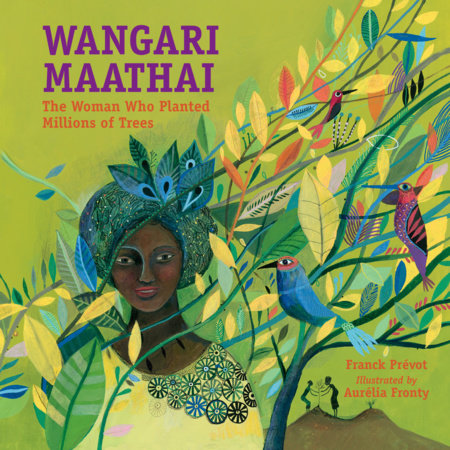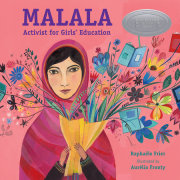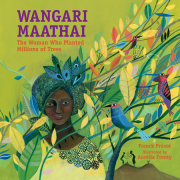*Wangari Maathai's biographical details, including, of course, her creation of Kenya's Green Belt Movement, are explicitly linked to feminist and human rights issues during her lifetime in this picture book. After an introduction to Wangari Maathai as a woman who "carried out her important work with important people"—and an immediate, affirming reference to "village women" as important people—the text moves into a present-tense description of the life and times of Wangari, "she who belongs to the leopard." Every double-page spread features striking, stylized artwork in lush colors, enhancing a thoughtful text. Predominant Kenyan attitudes toward women are boldly laid out: "Who is this woman who confronts them [Kenya's governing males] with a confident voice in a country where women are supposed to listen and lower their eyes in men's presence?" Similarly, the United States is indicted for its treatment of blacks during Wangari's years of education there, and President Daniel arap Moi is exposed as both an anti-environmentalist and a man "who orders police to shoot at crowds of demonstrators." The effects of British colonialism and tribal differences are also economically folded in. The biography officially concludes with Maathai's Nobel Peace Prize and is followed by an abundance of further information. This slim but emphatic biography stands out among others about Wangari Maathai with its well-crafted treatment of political issues.
- Kirkus Reviews, *starred review
*Prevot offers a gorgeous addition to the several books already available on Kenyan environmentalist and political activist Wangari Maathai, with as much biographical information as the pages can support. The writing is artful, clear, and concise, with references to Maathai’s native Swahili language and the cultural connections to the environment. This book provides students a beginning for research on her early life through the political turmoil of a corrupt Kenyan government which fell in 2002; it will also support deeper understanding of how she earned the Novel Peace Prize in 2004 for starting the Green Belt Movement, an NGO dedicated to planting trees, protecting the environment, and promoting women’s rights. Fronty’s art shines bright, expanding the text with styles that echo Henri Rousseau, Henri Matisse, and others. Of the other picture book biographies on Maathai, most focus on the tree planting rather than her life; this one offers appropriate information about the political upheavals that influenced Maathai.
-School Library Journal, *starred review
Dramatic and dreamlike paintings celebrate Nobel Peace Prize–winner Wangari Maathai, founder of the Green Belt movement. As a child in Kenya, Maathai learned the importance of nurturing forests, and after receiving her high-school diploma “at a time when very few African women even learn[ed] to read,” she traveled to the U.S. There, she studied the connections between environmental destruction, poverty, and oppression before returning to Kenya: “She asks that people think about the future even if the present is harsh and difficult.” Fronty’s fluid artwork incorporates organic motifs and African textile patterns to stirring effect, and extensive appended materials offer powerful supplemental information to conclude this standout tribute to Maathai’s perseverance and hard-won successes.
-Publishers Weekly, *starred review









